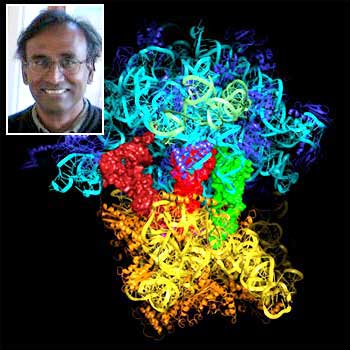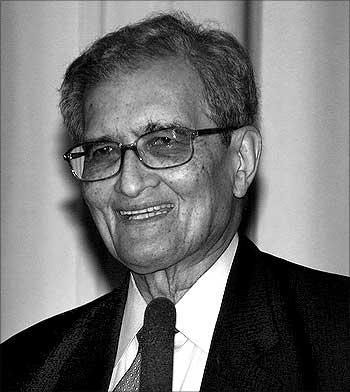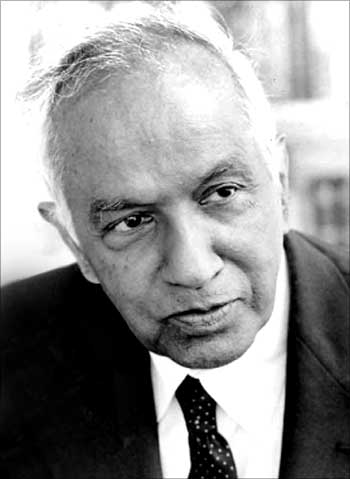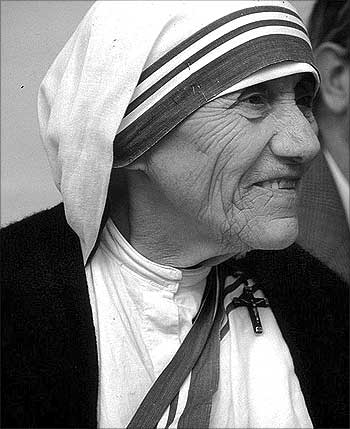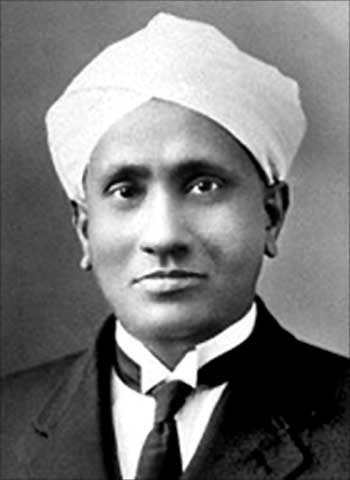 | « Back to article | Print this article |
Dr Ramakrishnan - Chemistry Nobel, 2009
Tamil Nadu-born Venkatraman Ramakrishnan, a senior scientist at the MRC Laboratory of Molecular Biology at Cambridge, has been awarded the Nobel Prize in Chemistry for 2009 along with two others, the Nobel Committee announced on Wednesday.
Born in 1952 in Chidambaram, Ramakrishnan shares the Nobel prize with Thomas E Steitz (US) and Ada E Yonath (Israel) for their "studies of the structure and function of the ribosome".
All three have used a method called X-ray crystallography to map the position for each and every one of the hundreds of thousands of atoms that make up the ribosome, it said.
"This year's three Laureates have all generated 3D models that show how different antibiotics bind to the ribosome. These models are now used by scientists to develop new antibiotics, directly assisting the saving of lives and decreasing humanity's suffering," the citation said. Click on NEXT to read about other Indian Nobel laureates...
Amartya Sen - Economics Nobel, 1998
Amartya Sen won the 1998 Nobel Prize in Economics for his contributions to welfare economics.
His contributions ranged from axiomatic theory of social choice, over definitions of welfare and poverty indexes, to empirical studies of famine. They were tied closely together by a general interest in distributional issues and a particular interest in the most impoverished members of society.
Sen clarified the conditions, which permitted aggregation of individual values into collective decisions, and the conditions that permitted rules for collective decision making that are consistent with a sphere of rights for the individual.
In empirical studies, Sen's applications of his theoretical approach enhanced the understanding of the economic mechanisms underlying famines.
How should income inequality be measured? When and how can we compare the distribution of welfare in different societies? How should we best determine whether poverty is on the decline? What are the factors that trigger famines?
By answering questions such as these, Amartya Sen made a number of noteworthy contributions to central fields of economic science and opened up new fields of study for subsequent generations of researchers.
S Chandrasekhar - Physics Nobel, 1983
Subrahmanyan Chandrasekhar was awarded the 1983 Nobel Prize in Physics for his theoretical studies of the physical processes of importance to the structure and evolution of the stars.
He was the first to show how the fate of a star lies in its own birth mass. On a long sea voyage from India to England in 1930, Chandrasekhar passed the time by developing a theory that proposed that a stable white dwarf couldn't be the fate of stars above a certain critical mass.
According to his calculations, stars more than 1.4 times the mass of the Sun, which became known as the Chandrasekhar limit, must collapse under the force of their own weight, and be destined for a more spectacular fate.
If the original star was up to 2-3 times the mass of the Sun, the collapsed corpses left behind from the explosion end up as highly dense neutron stars. Stars that are more than 2-3 times the mass of the Sun suffered an even more exotic death -- the force of gravity becomes so strong that matter disappears entirely into a black hole.
Chandrasekhar adopted a highly unusual approach to his research, investigating a fresh field of study each decade, such as how stars die, how radiation passes through a star's atmosphere and the theory of black holes.
Mother Teresa - Peace Nobel, 1979
The 1979 Nobel Peace Prize was awarded to Mother Teresa.
In the late 1940's, Mother Teresa left her teaching post at a Roman Catholic girls' school in Calcutta in order to devote her life to working among the poorest of the poor in the slums of that city.
The Norwegian Nobel Committee expressed its recognition of Mother Teresa's work in bringing help to suffering humanity.
The Committee placed special emphasis on the spirit that inspired her activities and which was the tangible expression of her personal attitude and human qualities.
A feature of her work was respect for the individual human being, for his or her dignity and innate value. The loneliest, the most wretched and the dying have, at her hands, received compassion without condescension, based on reverence for man.
In Mother Teresa's case, this basic philosophy of life was firmly rooted in her Christian faith. In Calcutta and elsewhere, she enlisted the help of assistants from other religious denominations.
Har Gobind Khorana - Medicine Nobel, 1968
Har Gobind Khorana won the 1968 Nobel Prize in Medicine for his interpretation of the genetic code and its function in protein synthesis. He shared this award with American scientists Robert W. Holley and Marshall W Nirenberg.
An American molecular biologist of Indian Punjabi origin, Dr. Khorana was responsible for producing the first man made gene in his laboratory.
His work helped bring closer the day when synthetic DNA may be introduced into the defective human tissues to bring about their repair or treat mentally retarded people and change them into more intelligent and healthy human beings.
His synthesis of RNA, capable of replication in laboratory, was a step towards the creation of life artificially. In fact, the researches opened up a new branch called Genetic Engineering in Science.
The biological language is common to all living organisms. Dr Khorana and his team had established that the mother of all codes is spelled out in three-letter words. He was also the first to synthesize oligonucleotides, that is, strings of nucleotides.
CV Raman - Physics Nobel, 1930
Chandrasekhara Venkata Raman won the 1930 Nobel Prize in Physics for his work on the scattering of light and for the discovery of the effect named after him.
Raman made, in 1928, the unexpected and highly surprising discovery that the scattered light showed not only the radiation that derived from the primary light but also a radiation that contained other wavelengths, which were foreign to the primary light.
Raman investigated the universal character of the phenomenon by using a large number of substances as a scattering medium, and everywhere found the same effect.
The explanation of this phenomenon, which has received the name of the "Raman effect" after its discoverer, has been found by Raman himself with the help of the modern conception of the nature of light.
According to that conception, light cannot be emitted from or absorbed by material otherwise than in the form of definite amounts of energy or what are known as "light quanta".
Thus the energy of light would possess a kind of atomic character. A quantum of light is proportionate to the frequency of rays of light, so that in the case of a frequency twice as great, the quanta of the rays of light will also be twice as great.
Rabindranath Tagore - Literature Nobel, 1913
Rabindranath Tagore won the 1913 Nobel Prize in Literature for his profoundly sensitive, fresh and beautiful verses in Gitanjali by which he made his poetic thought a part of the literature of the West.
Tagore's Gitanjali: Song Offerings (1912), a collection of religious poems, was the one of his works that especially arrested the attention of the selecting critics.
The features of this poetry that won immediate and enthusiastic admiration were the perfection with which the poet's own ideas and those he borrowed were harmonised into a complete whole.
His rhythmically balanced style -- to quote an English critic's opinion, 'combines at once the feminine grace of poetry with the virile power of prose' -- his austere, by some termed classic, taste in the choice of words and his use of the other elements of expression in a borrowed tongue -- those features, in short, that stamp an original work as such.
The same estimate was revealed in 1913 in his work titled The Gardener, Lyrics of Love and Life. In this work, however, as Tagore himself pointed out, he recast rather than interpret his earlier inspirations. The world saw another phase of his personality, now subject to the alternately blissful and torturing experiences of youthful love, now prey to the feelings of longing and joy that the vicissitudes of life give rise to, the whole interspersed nevertheless with glimpses of a higher world.
Intergovernmental Panel on Climate Change - Peace Nobel, 2007
In 2007, Rajendra Pachouri headed Intergovernmental Panel on Climate Change (IPCC) and Albert Arnold (Al) Gore Jr jointly won the Nobel Peace Prize for their efforts to build up and disseminate greater knowledge about man-made climate change, and to lay the foundations for the measures that are needed to counteract such change.
Through the scientific reports issued over the past two decades, the IPCC created an ever-broader informed consensus about the connection between human activities and global warming.
Thousands of scientists and officials from over one hundred countries have collaborated to achieve greater certainty as to the scale of the warming. Whereas in the 1980s global warming seemed to be merely an interesting hypothesis, the 1990s produced firmer evidence in its support.
